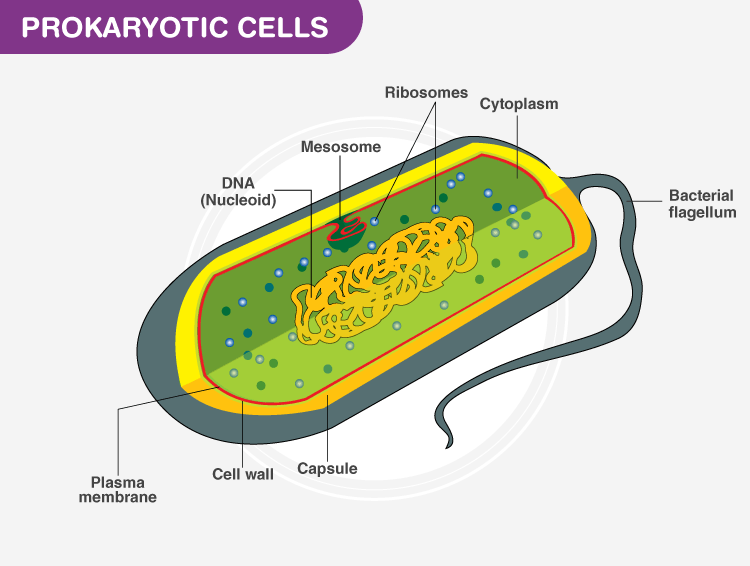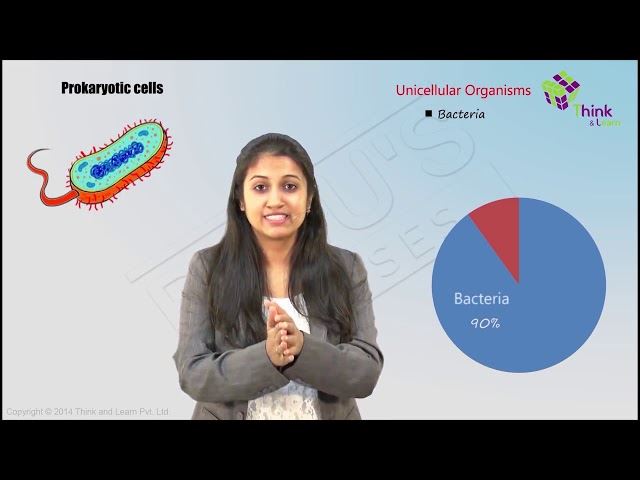Prokaryotic Cell Definition
“Prokaryotic cells are the cells that do not have a true nucleus and membrane-bound organelles.”
Table of Contents
What is a Prokaryotic Cell?
Prokaryotic cells are single-celled microorganisms known to be the earliest on earth. Prokaryotes include Bacteria and Archaea. The photosynthetic prokaryotes include cyanobacteria that perform photosynthesis.
A prokaryotic cell consists of a single membrane and therefore, all the reactions occur within the cytoplasm. They can be free-living or parasites.
Characteristics of Prokaryotic Cell
Prokaryotic cells have different characteristic features. The characteristics of the prokaryotic cells are mentioned below.
-
They lack a nuclear membrane.
-
Mitochondria, Golgi bodies, chloroplast, and lysosomes are absent.
-
The genetic material is present on a single chromosome.
-
The histone proteins, the important constituents of eukaryotic chromosomes, are lacking in them.
-
The cell wall is made up of carbohydrates and amino acids.
-
The plasma membrane acts as the mitochondrial membrane carrying respiratory enzymes.
-
They divide asexually by binary fission. The sexual mode of reproduction involves conjugation.
Prokaryotic Cell Structure
A prokaryotic cell does not have a nuclear membrane. However, the genetic material is present in a region in the cytoplasm known as the nucleoid. They may be spherical, rod-shaped, or spiral. A prokaryotic cell structure is as follows:
-
Capsule– It is an outer protective covering found in the bacterial cells, in addition to the cell wall. It helps in moisture retention, protects the cell when engulfed, and helps in the attachment of cells to nutrients and surfaces.
-
Cell Wall– It is the outermost layer of the cell which gives shape to the cell.
-
Cytoplasm– The cytoplasm is mainly composed of enzymes, salts, cell organelles and is a gel-like component.
-
Cell Membrane– This layer surrounds the cytoplasm and regulates the entry and exit of substances in the cells.
-
Pili– These are hair-like outgrowths that attach to the surface of other bacterial cells.
-
Flagella– These are long structures in the form of a whip, that help in the locomotion of a cell.
-
Ribosomes– These are involved in protein synthesis.
-
Plasmids– Plasmids are non-chromosomal DNA structures. These are not involved in reproduction.
-
Nucleoid Region– It is the region in the cytoplasm where the genetic material is present.
A prokaryotic cell lacks certain organelles like mitochondria, endoplasmic reticulum, and Golgi bodies.
Prokaryotic Cell Diagram
The prokaryotic cell diagram given below represents a bacterial cell. It depicts the absence of a true nucleus and the presence of a flagellum that differentiates it from a eukaryotic cell.

Prokaryotic Cell Diagram illustrates the absence of a true nucleus
Components of Prokaryotic Cells
The prokaryotic cells have four main components:
Plasma Membrane- It is an outer protective covering of phospholipid molecules which separates the cell from the surrounding environment.
Cytoplasm- It is a jelly-like substance present inside the cell. All the cell organelles are suspended in it.
DNA- It is the genetic material of the cell. All the prokaryotes possess a circular DNA. It directs what proteins the cell creates. It also regulates the actions of the cell.
Ribosomes- Protein synthesis occurs here.
Some prokaryotic cells possess cilia and flagella which helps in locomotion.
Reproduction in Prokaryotes
A prokaryote reproduces in two ways:
-
Asexually by binary fission
-
Sexually by conjugation
Binary Fission
-
The DNA of an organism replicates and the new copies attach to the cell membrane.
-
The cell wall starts increasing in size and starts moving inwards.
-
A cell wall is then formed between each DNA, dividing the cell into two daughter cells.
Recombination
In this process, genes from one bacteria are transferred to the genome of other bacteria. It takes place in three ways-conjugation, transformation, transduction.
-
Conjugation is the process in which genes are transferred between two bacteria through a protein tube structure called a pilus.
-
Transformation is the mode of sexual reproduction in which the DNA from the surroundings is taken by the bacterial cell and incorporated in its DNA.
-
Transduction is the process in which the genetic material is transferred into the bacterial cell with the help of viruses. Bacteriophages are the virus that initiates the process.
Related Video:

Examples of Prokaryotic Cells
The examples of the prokaryotic cells are mentioned below:
Bacterial Cells
These are unicellular organisms found everywhere on earth from soil to the human body.
They have different shapes and structures.
The cell wall is composed of peptidoglycan that provides structure to the cell wall.
Bacteria have some unique structures such as pili, flagella and capsule.
They also possess extrachromosomal DNA known as plasmids.
They have the ability to form tough, dormant structures known as endospores that helps them to survive under unfavourable conditions. The endospores become active when the conditions are favourable again.
Archaeal Cells
Archaebacteria are unicellular organisms similar to bacteria in shape and size.
They are found in extreme environments such as hot springs and other places such as soil, marshes, and even inside humans.
They have a cell wall and flagella. The cell wall of archaea does not contain peptidoglycan.
The membranes of the archaea have different lipids with a completely different stereochemistry.
Just like bacteria, archaea have one circular chromosome. They also possess plasmids.
For more information on Prokaryotic Cells, its definition, structure, characteristics and examples, keep visiting BYJU’S Biology website or download BYJU’S app for further reference.
Related Links
| Difference between a prokaryotic cell and eukaryotic cell |
| Difference between an archaea and bacteria |
Frequently Asked Questions
What are the structural features of prokaryotic cells?
The prokaryotic cell structure is composed of:
- Cell wall
- Cell membrane
- Capsule
- Pili
- Flagella
- Ribosomes
- Plasmids
How is the prokaryotic cell structure different from that of the eukaryotic cell?
Prokaryotic cells lack a true nucleus. The nucleus is devoid of the nuclear membrane. On the contrary, the nucleus of the eukaryotic cells is enclosed by a nuclear membrane. A prokaryotic cell also lacks mitochondria and chloroplast, unlike a eukaryotic cell.
How does a prokaryotic cell divide?
Prokaryotic cells undergo asexual reproduction. Most prokaryotic cells divide by binary fission, where the cells divide into two daughter cells.
Why is the process of cell division in prokaryotic cells different from that in eukaryotes?
Prokaryotic cells are simpler than eukaryotic cells. They do not have a nuclear membrane surrounding their DNA, therefore, cell division is different than that in eukaryotes.
When did the prokaryotic cells evolve?
The first prokaryotic cells evolved around 3.5 billion years ago. The eukaryotic cells were formed after the prokaryotic cells and are believed to have evolved from them.

Thanks
excellent work done
Are the ribosomes of prokaryotes membrane-bounded or with no membrane?
Ribosomes float freely in prokaryotes
I really love the way questions are answered here keep it up
Why the virus having only DNA or RNA? Plz reply
Superb ✌️